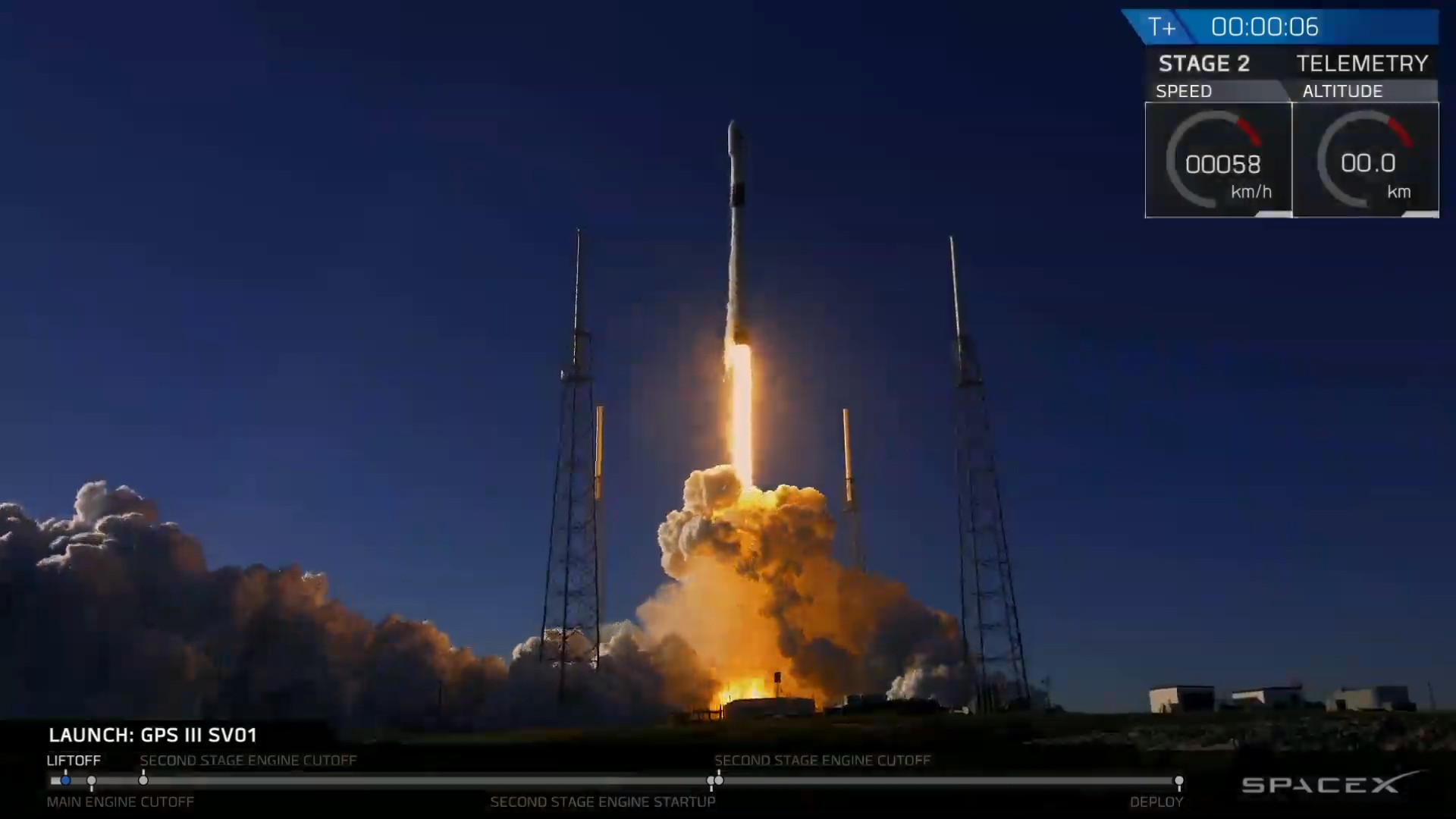The United States' venerable Global Positioning System (GPS) is about to get a shot in the arm.
The first advanced, next-generation "GPS III" satellite soared into space today (Dec. 23) atop a two-stage SpaceX Falcon 9 rocket, which launched from Cape Canaveral Air Force Station in Florida at 8:51 a.m. EST (1351 GMT) after nearly a week of delays. The spacecraft, dubbed "Vespucci," was deployed into medium Earth orbit about 2 hours after liftoff.
SpaceX has launched payloads for the U.S. military before, but Vespucci is the company's first official "National Security Space" mission — a designation reserved for liftoffs deemed critical to national defense. [See Photos of SpaceX's GPS III Satellite Launch!]
SpaceX usually attempts to land Falcon 9 first stages shortly after liftoff for future reuse, but that didn't happen today. The rocket flew in an expendable configuration, without any landing legs, at the request of SpaceX's customer, the U.S. Air Force.
"There simply was not a performance reserve to meet our requirements and allow for this mission to bring the first stage back," Walter Lauderdale, mission director at the Air Force's Space and Missile Systems Center (SMC) Launch Enterprise Systems Directorate, said during a prelaunch call with reporters on Dec. 14.

It's possible that future SpaceX GPS III missions could feature first-stage landing attempts, Lauderdale added; it depends on what the data from this flight show. (SpaceX is under contract to launch four additional GPS III spacecraft.)
The GPS constellation provides precise positioning, navigation and timing (PNT) information to a variety of users, from soldiers in the field to drivers trying to find the best route through rush-hour traffic.
Get the Space.com Newsletter
Breaking space news, the latest updates on rocket launches, skywatching events and more!
The network currently features 31 operational satellites, which orbit about 12,550 miles (20,200 kilometers) above Earth. The SUV-size Vespucci, which weighed 9,700 lbs. (4,400 kilograms) at launch, won't push that number up; it will replace a GPS craft known as SVN-43, which launched in July 1997.
The solar-powered Vespucci will provide a number of advantages over the old-guard satellites, Air Force officials said. For example, the new satellite will deliver PNT information three times more accurate than that of currently operational GPS craft. (The constellation now allows users to locate objects on the ground with an average accuracy of about 20 inches, or 50 centimeters.)
In addition, "we're going to see an increase in power," Col. Steve Whitney, director of the SMC Global Positioning Systems Directorate, said in the Dec. 14 telecon. "We put a requirement on there to produce stronger signals, to try and fight through some of that jamming that we see, particularly on our military signals."
GPS III signals will also be compatible with other satellite-navigation systems, Whitney said, which should "maximize the availability and accuracy of navigation signals worldwide."
But it'll be a while before Vespucci, which was built by aerospace company Lockheed Martin, is fully up and running. It'll likely take six to nine months to perform checkouts on the satellite in orbit, and a similar amount of time to do an integrated-systems test of the newly constituted constellation, Whitney said.
The 31 currently operational GPS satellites belong to four different iterations — Block IIA, which launched from 1990 to 1997; Block IIR, which lifted off from 1997 to 2004; Block II-RM, which launched from 2005 to 2009; and Block IIF, which took to the skies from 2010 to 2016.
Satellites in Blocks IIA, IIR and II-RM were designed to operate for at least 7.5 years on orbit, and Block IIF craft have design lifetimes of 12 years. GPS III satellites such as Vespucci are built to keep working for at least 15 years. (GPS satellites commonly outlast their design lifetimes by considerable margins, however.)
Vespucci's nickname honors Italian cartographer and explorer Amerigo Vespucci, after whom North and South America were named.
This morning's launch was originally scheduled to occur on Tuesday (Dec. 18), but SpaceX called off that attempt after receiving an "out of family" reading from sensors on the Falcon 9's first stage. Bad weather thwarted two more launch attempts on Thursday (Dec. 20) and Saturday (Dec. 22).
The successful GPS III SV01 mission marked SpaceX's 21st and final launch of 2018, beating the company's 2017 flight rate of 18 launches.
Mike Wall's book about the search for alien life, "Out There" (Grand Central Publishing, 2018; illustrated by Karl Tate) is out now. Follow him on Twitter @michaeldwall. Follow us @Spacedotcom or Facebook. Originally published on Space.com.
Join our Space Forums to keep talking space on the latest missions, night sky and more! And if you have a news tip, correction or comment, let us know at: community@space.com.

Michael Wall is a Senior Space Writer with Space.com and joined the team in 2010. He primarily covers exoplanets, spaceflight and military space, but has been known to dabble in the space art beat. His book about the search for alien life, "Out There," was published on Nov. 13, 2018. Before becoming a science writer, Michael worked as a herpetologist and wildlife biologist. He has a Ph.D. in evolutionary biology from the University of Sydney, Australia, a bachelor's degree from the University of Arizona, and a graduate certificate in science writing from the University of California, Santa Cruz. To find out what his latest project is, you can follow Michael on Twitter.









